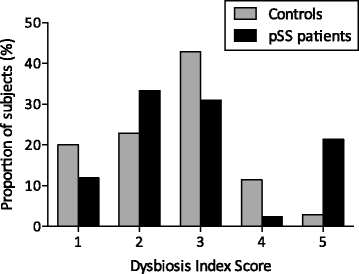Severe intestinal dysbiosis is prevalent in primary Sjögren's syndrome and is associated with systemic disease activity
- PMID: 29065905
- PMCID: PMC5655865
- DOI: 10.1186/s13075-017-1446-2
Severe intestinal dysbiosis is prevalent in primary Sjögren's syndrome and is associated with systemic disease activity
Abstract
Background: Altered microbial composition of the intestine, commonly referred to as dysbiosis, has been associated with several autoimmune diseases including primary Sjögren's syndrome (pSS). The aims of the current study were to study the intestinal microbial balance in pSS and to identify clinical features associated with dysbiosis.
Methods: Forty-two consecutive pSS patients and 35 age-matched and sex-matched control subjects were included in the study in an open clinic setting. Stool samples were analyzed for intestinal dysbiosis using a validated 16S rRNA-based microbiota test (GA-map™ Dysbiosis Test; Genetic Analysis, Oslo, Norway). Dysbiosis and severe dysbiosis were defined in accordance with the manufacturer's instructions. Patients were evaluated with regard to disease activity (European League Against Rheumatism (EULAR) Sjögren's Syndrome Disease Activity Index (ESSDAI) and Clinical ESSDAI (ClinESSDAI)). In addition, patients were examined for laboratory and serological features of pSS as well as fecal calprotectin levels. Furthermore, patients were investigated regarding patient-reported outcomes for pSS (EULAR Sjögren's Syndrome Patient Reported Index (ESSPRI)) and irritable bowel syndrome (IBS)-like symptoms according to the Rome III criteria.
Results: Severe dysbiosis was more prevalent in pSS patients in comparison to controls (21 vs 3%; p = 0.018). Subjects with pSS and severe dysbiosis had higher disease activity as evaluated by the ESSDAI total score (13 vs 5; p = 0.049) and the ClinESSDAI total score (12 vs 5; p = 0.049), lower levels of complement component 4 (0.11 vs 0.17 g/L; p = 0.004), as well as higher levels of fecal calprotectin (110 vs 33 μg/g; p = 0.001) compared to the other pSS patients. In contrast, severe dysbiosis among pSS patients was not associated with disease duration, IBS-like symptoms, or the ESSPRI total score.
Conclusions: Severe intestinal dysbiosis is a prevalent finding in pSS and is associated both with clinical and laboratory markers of systemic disease activity as well as gastrointestinal inflammation. Further studies are warranted to elucidate a potential causative link between dysbiosis and pSS.
Keywords: Disease activity; Dysbiosis; Gastrointestinal; Microbiome; Primary Sjögren’s syndrome.
Conflict of interest statement
Ethics approval and consent to participate
The study was approved by the Regional Ethics Review Board, Lund, Sweden (LU 2011/596). All patients and controls gave written informed consent according to the declaration of Helsinki.
Consent for publication
Not applicable.
Competing interests
The authors of the study declare that they have no competing interests.
Publisher's Note
Springer Nature remains neutral with regard to jurisdictional claims in published maps and institutional affiliations.
Figures


Similar articles
-
Elevated levels of faecal calprotectin in primary Sjögren's syndrome is common and associated with concomitant organic gastrointestinal disease.Arthritis Res Ther. 2016 Jan 12;18:9. doi: 10.1186/s13075-015-0907-8. Arthritis Res Ther. 2016. PMID: 26759247 Free PMC article.
-
European League Against Rheumatism Sjögren's Syndrome Disease Activity Index and European League Against Rheumatism Sjögren's Syndrome Patient-Reported Index: a complete picture of primary Sjögren's syndrome patients.Arthritis Care Res (Hoboken). 2013 Aug;65(8):1358-64. doi: 10.1002/acr.21991. Arthritis Care Res (Hoboken). 2013. PMID: 23436737
-
Connection between the Gut Microbiome, Systemic Inflammation, Gut Permeability and FOXP3 Expression in Patients with Primary Sjögren's Syndrome.Int J Mol Sci. 2020 Nov 19;21(22):8733. doi: 10.3390/ijms21228733. Int J Mol Sci. 2020. PMID: 33228011 Free PMC article.
-
Outcome measures for primary Sjögren's syndrome: a comprehensive review.J Autoimmun. 2014 Jun;51:51-6. doi: 10.1016/j.jaut.2013.12.010. Epub 2014 Jan 8. J Autoimmun. 2014. PMID: 24411404 Review.
-
Sjögren's Disease and Gastroesophageal Reflux Disease: What Is Their Evidence-Based Link?Medicina (Kaunas). 2024 Nov 18;60(11):1894. doi: 10.3390/medicina60111894. Medicina (Kaunas). 2024. PMID: 39597079 Free PMC article. Review.
Cited by
-
The gut-eye-lacrimal gland-microbiome axis in Sjögren Syndrome.Ocul Surf. 2020 Apr;18(2):335-344. doi: 10.1016/j.jtos.2019.10.006. Epub 2019 Oct 20. Ocul Surf. 2020. PMID: 31644955 Free PMC article. Review.
-
A Glimpse Into the Microbiome of Sjögren's Syndrome.Front Immunol. 2022 Jul 14;13:918619. doi: 10.3389/fimmu.2022.918619. eCollection 2022. Front Immunol. 2022. PMID: 35911741 Free PMC article. Review.
-
Copper Deficiency Myeloneuropathy in Autoimmune Disease.Cureus. 2021 Jul 23;13(7):e16591. doi: 10.7759/cureus.16591. eCollection 2021 Jul. Cureus. 2021. PMID: 34434682 Free PMC article.
-
Nanoparticles in the Food Industry and Their Impact on Human Gut Microbiome and Diseases.Int J Mol Sci. 2021 Feb 16;22(4):1942. doi: 10.3390/ijms22041942. Int J Mol Sci. 2021. PMID: 33669290 Free PMC article. Review.
-
Epitope Mapping of Pathogenic Autoantigens on Sjögren's Syndrome-Susceptible Human Leukocyte Antigens Using In Silico Techniques.J Clin Med. 2022 Mar 18;11(6):1690. doi: 10.3390/jcm11061690. J Clin Med. 2022. PMID: 35330015 Free PMC article.
References
-
- Seror R, Ravaud P, Bowman SJ, Baron G, Tzioufas A, Theander E, Gottenberg JE, Bootsma H, Mariette X, Vitali C. EULAR Sjogren's syndrome disease activity index: development of a consensus systemic disease activity index for primary Sjogren's syndrome. Ann Rheum Dis. 2010;69(6):1103–9. doi: 10.1136/ard.2009.110619. - DOI - PMC - PubMed
-
- Ramos-Casals M, Brito-Zeron P, Solans R, Camps MT, Casanovas A, Sopena B, Diaz-Lopez B, Rascon FJ, Qanneta R, Fraile G, Perez-Alvarez R, Callejas JL, Ripoll M, Pinilla B, Akasbi M, Fonseca E, Canora J, Nadal ME, de la Red G, Fernandez-Regal I, Jimenez-Heredia I, Bosch JA, Ayala MD, Morera-Morales L, Maure B, Mera A, Ramentol M, Retamozo S, Kostov B. Systemic involvement in primary Sjogren's syndrome evaluated by the EULAR-SS disease activity index: analysis of 921 Spanish patients (GEAS-SS Registry) Rheumatology (Oxford) 2014;53:321–31. doi: 10.1093/rheumatology/ket349. - DOI - PubMed
MeSH terms
Substances
LinkOut - more resources
Full Text Sources
Other Literature Sources
Medical

